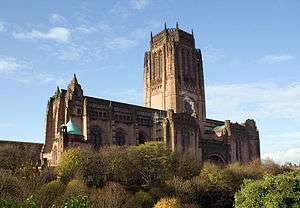Stanley Dock Tobacco Warehouse
Coordinates: 53°25′16″N 2°59′55″W / 53.4210°N 2.9985°W
| Stanley Dock Tobacco Warehouse | |
|---|---|
|
| |
| General information | |
| Town or city | Liverpool |
| Country |
|
| Construction started | 1900 |
| Completed | 1901 |
| Client | Mersey Docks Estates |
| Height | 125 ft (38 m) |
| Technical details | |
| Size | 36 acres (15 ha) |
| Design and construction | |
| Architect | A.G. Lyster |
The Stanley Dock Tobacco Warehouse is a grade II listed building and is the world's largest brick warehouse.[1][2][3] It is adjacent to the Stanley Dock, in Liverpool, England. Standing 125 feet (38 m) high, the building was, at the time of its construction in 1901, claimed to be the world's largest building in terms of area.[2][4][5] The 14 storey building spans across 36 acres (15 ha) and its construction used 27 million bricks, 30,000 panes of glass and 8,000 tons of steel.[1][5]
The overall design is by A. G. Lyster, the Dock Engineer, but Arthur Berrington almost certainly played a part. The warehouse was a late addition to the Stanley Dock complex and was built on land reclaimed from the dock. Stanley Dock is accessible from the dock system or by barge from the Leeds and Liverpool Canal which enters under Great Howard Street bridge.
With the decline of trade going through Liverpool, the warehouse fell into disuse in the 1980s and gradually into disrepair. More recently the building has featured in the Stop the Rot conservation campaign by the Liverpool Echo newspaper. Part of the ground floor of the warehouse was used for the Sunday Heritage Market. In 2010 local club promoter Sean Weaver held a warehouse rave on Boxing Day, which saw 2,500 people descend on the building. Acts included DJ Rolando, Kids In Glass Houses lead singer Aled Phillips, Hatcha and Chrispy, as well as a plethora of local DJs from the area.[6]
Various plans have been unveiled for the Tobacco Warehouse to be redeveloped into several hundred apartments as part of a larger development of the whole Stanley Dock site. The plans involve hollowing out the centre of the warehouse to create a garden-filled courtyard.[7][8][9]
In 2014 the Irish company who had previously transformed Belfast's Titanic Quarter, Harcourt Development, put forward a proposal for the warehouse to be converted into 476 apartments accompanied by businesses, cafes and retail outlets on the ground floor.[10]
References
- 1 2 "The Stanley Dock Tobacco Warehouse". Liverpool World Heritage. Retrieved 12 April 2008.
- 1 2 "Liverpool". World Heritage Site. Retrieved 12 April 2008.
- ↑ "Trading Places: A History of Liverpool Docks (Stanley Dock)". Liverpool Museums. Retrieved 12 April 2008.
- ↑ "Liverpool Docks". timbosliverpool.co.uk. Retrieved 12 April 2008.
- 1 2 Nicholls, Robert (2008). Curiosities of Merseyside. The History Press.
- ↑ "Tobacco Warehouse website". Archived from the original on 24 July 2012. Retrieved 20 May 2014.
- ↑ "Stanley Dock transformed". Liverpool Echo. 27 March 2007. Retrieved 12 April 2008.
- ↑ "£100m plan for tobacco building". Liverpool Echo. 6 September 2010.
- ↑ "Dock market fear for jobs". Liverpool Echo. 6 September 2010.
- ↑ Belger, Tom (6 October 2014). "The Evening Read: Stanley Dock in Liverpool facing an exciting future". Liverpool Echo. Retrieved 22 November 2015.
External links
| Wikimedia Commons has media related to Stanley Dock. |
- Stop the Rot campaign
- Historic England. "Details from image database (359563)". Images of England.
- The Stanley Dock Conservation Area
- Birdseye view of the Stanley Dock warehouses
- Liverpool North Docks views
- Photographs of Stanley Dock
- Inside The Tobacco Warehouse
- Tobacco Warehouse on Wayback Machine


